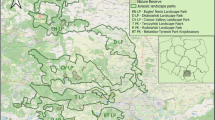Abstract
The composition and distribution of polycyclic aromatic hydrocarbons (PAHs) were studied in organomineral and organic soils of the Meshchera National Park. It was found that the background oligotrophic peat soils unaffected by fires in central parts of the bogs are characterized by the increased PAH concentrations due to their high sorption capacity. The fires of 2007 and 2010 resulted in the transformation of the plant cover and soil morphology, the formation of new horizons, and the change in the PAHs content and composition. Significant burn-off of organic matter was found in oligotrophic-eutrophic soils and resulted in the decrease of PAHs content after fire. Only partial burn-off of organic horizons and intense formation of PAHs were recorded in the soil with initially great thickness of peat horizons. Pyrogenic accumulation of PAHs was identified in organomineral soils of the marginal parts of bogs and of forest sites.
Similar content being viewed by others
References
G. N. Annenskaya, I. I. Mamai, and Yu. N. Tsesel’chuk, Landscapes of Ryazan Meshchera and Potentiality for Their Development (Moscow State University, Moscow, 1983) [in Russian].
D. N. Gabov, V. A. Beznosikov, B. M. Kondratenok, and E. V. Yakovleva, “Formation of polycyclic aromatic hydrocarbons in northern and middle taiga soils,” Eurasian Soil Sci. 41 (11), 1180–1188 (2008).
A. N. Gennadiev and A. S. Tsibart, “Pyrogenic polycyclic aromatic hydrocarbons in soils of reserved and anthropogenically modified areas: factors and features of accumulation,” Eurasian Soil Sci. 46 (1), 28–36 (2013).
Geochemistry of Polycyclic Aromatic Hydrocarbons in Rocks and Soils, Ed. by A. N. Gennadiev and Yu. I. Pikovskii (Moscow State University, Moscow, 1996) [in Russian].
Classification and Diagnostic System of Russian Soils (Oikumena, Smolensk, 2004) [in Russian].
E. Yu. Maksimova, A. S. Tsibart, and E. V. Abakumov, “Soil properties in the Tolyatti pine forest after the 2010 catastrophic wildfires,” Eurasian Soil Sci. 47 (9), 940–951 (2014).
Vegetation of the European Part of the Soviet Union (Nauka, Leningrad, 1980) [in Russian].
F. Ya. Rovinskii, T. A. Teplitskaya, and T. A. Alekseeva, Background Monitoring of Polycyclic Aromatic Hydrocarbons (Gidrometeoizdat, Leningrad, 1988) [in Russian].
A. S. Tsibart and A. N. Gennadiev, “Polycyclic aromatic hydrocarbons in soils: sources, behavior, and indication significance (a review),” Eurasian Soil Sci. 46 (7), 728–741 (2013).
A. A. Dymov and D. N. Gabov, “Pyrogenic alterations of podzols at the Northeast European part of Russia: Morphology, carbon pools, PAH content,” Geoderma 241–242, 230–237 (2015).
M. S. Garcia-Falcoan, B. Soto-Gonzalez, and J. Simal-Gaandara, “Evolution of the concentrations of polycyclic aromatic hydrocarbons in burnt woodland soils,” Environ. Sci. Technol. 40, 759–763 (2006).
F. Gonzalez-Vila, J. Lopez, F. Martin, and J. del Rio, “Determination in soils of PAH produced by combustion of biomass under different conditions,” Fresenius J. Anal Chem. 339, 750–753 (1991).
R. A. Hartford and W. H. Frandsen, “When it’s hot, it’s hot… or maybe it’s not! (Surface flaming may not portend extensive soil heating),” Int. J. Wildland Fire 2 (3), 139–144 (1992).
A. Khan, M. Ishaq, and M. Khan, “Effect of vehicle exhaust on the quantity of polycyclic aromatic hydrocarbons (PAHs) in soil,” Environ. Monit. Ass. 137, 363–369 (2008).
O. L. Maioli, B. A. Knoppers, and D. A. Azevedo, “Sources, distribution and variability of hydrocarbons in total atmospheric suspended particulates of two Brazilian areas influenced by sugarcane burning,” J. Atmos. Chem. 64, 159–178 (2009).
P. Masclet, H. Cachier, C. Liousse, and H. Wortham, “Emissions of polycyclic aromatic hydrocarbons by savanna fires,” J. Atmos. Chem. 22, 41–54 (1995).
A. Mastral and M. Callen, “A review on polycyclic aromatic hydrocarbon (PAH) emissions from energy generation,” Environ. Sci. Technol. 34, 3051–3057 (2000).
M. Radojevic, “Chemistry of forest fires and regional haze with emphasis on Southeast Asia,” Pure Appl. Geophys. 160, 157–187 (2003).
G. Rein, N. Cleaver, C. Ashton, P. Pironi, and J. L. Torero, “The severity of smouldering peat fires and damage to the forest soil,” Catena 74, 304–309 (2008).
A. Tsibart, A. Gennadiev, T. Koshovskii, and A. Watts, “Polycyclic aromatic hydrocarbons in post-fire soils of drained peatlands in western Meshchera (Moscow region, Russia),” Solid Earth 5, 1305–1317 (2014).
C. H. Vane, B. G. Rawlins, A. W. Kim, V. Moss-Hayes, C. P. Kendrick, and M. J. Leng, “Sedimentary transport and fate of polycyclic aromatic hydrocarbons (PAH) from managed burning of moorland vegetation on a blanket peat, South Yorkshire, UK,” Sci. Total Environ. 449, 81–94 (2013).
A. Vergnoux, L. Malleret, L. Asia, P. Doumenq, and F. Theraulaz, “Impact of forest fires on PAH level and distribution in soils,” Environ. Res. 111, 193–198 (2011).
Global Forest Change, Results from time-series analysis of Landsat images characterizing forest extent and change. http://earthenginepartners.appspot.com/science-2013-global-forest/
Space Research Institute, Department of satellite monitoring. http://smiswww.iki.rssi.ru/
Geoportal of Moscow State University. http://www.geogr.msu.ru/science/projects/geoportal/
Open Street Map. http://www.openstreetmap.org/
Author information
Authors and Affiliations
Corresponding author
Additional information
Original Russian Text © A.S. Tsibart, A.N. Gennadiev, T.S. Koshovskii, N.S. Gamova, 2016, published in Pochvovedenie, 2016, No. 3, pp. 312–320.
Rights and permissions
About this article
Cite this article
Tsibart, A.S., Gennadiev, A.N., Koshovskii, T.S. et al. Polycyclic aromatic hydrocarbons in pyrogenic soils of swampy landscapes of the Meshchera lowland. Eurasian Soil Sc. 49, 285–293 (2016). https://doi.org/10.1134/S106422931603011X
Received:
Published:
Issue Date:
DOI: https://doi.org/10.1134/S106422931603011X




